History of Alsace
The History of Alsace begins when the area was inhabited by nomadic hunters in antiquity, and includes several changes in political control of the area between Germany and France.
Pre-Roman Alsace
By 1500 BC, Celts began to settle in Alsace, clearing and cultivating the land. Alsace is a plain surrounded by the Vosges mountains (west) and the Black Forest mountains (east). It creates Foehn winds which, along with natural irrigation, contributes to the fertility of the soil. In a world of agriculture, Alsace has always been a rich region which explains why it suffered so many invasions and annexations in its history.
Roman Alsace
By 58 BC, the Romans had invaded and established Alsace as a center of viticulture. To protect this highly valued industry, the Romans built fortifications and military camps that evolved into various communities which have been inhabited continuously to the present day. While part of the Roman Empire, Alsace was part of Germania Superior.
Alemannic and Frankish Alsace
With the decline of the Roman Empire, Alsace became the territory of the Germanic Alemanni. The Alemanni were agricultural people, and their Germanic language formed the basis of modern-day dialects spoken along the Upper Rhine (Alsatian, Alemannian, Swabian, Swiss). Clovis and the Franks defeated the Alemanni during the 5th century AD, culminating with the Battle of Tolbiac, and Alsace became part of the Kingdom of Austrasia. Under Clovis' Merovingian successors the inhabitants were Christianized. Alsace remained under Frankish control until the Frankish realm, following the Oaths of Strasbourg of 842, was formally dissolved in 843 at the Treaty of Verdun; the grandsons of Charlemagne divided the realm into three parts. Alsace formed part of the Middle Francia, which was ruled by the eldest grandson Lothar I. Lothar died early in 855 and his realm was divided into three parts. The part known as Lotharingia, or Lorraine, was given to Lothar's son. The rest was shared between Lothar's brothers Charles the Bald (ruler of the West Frankish realm) and Louis the German (ruler of the East Frankish realm). The Kingdom of Lotharingia was short-lived, however, becoming the stem duchy of Lorraine in Eastern Francia after the Treaty of Ribemont in 880. Alsace was united with the other Alemanni east of the Rhine into the stem duchy of Swabia.
Alsace within the Holy Roman Empire
At about this time, the surrounding areas experienced recurring fragmentation and reincorporations among a number of feudal secular and ecclesiastical lordships, a common process in the Holy Roman Empire. Alsace experienced great prosperity during the 12th and 13th centuries under Hohenstaufen emperors. Frederick I set up Alsace as a province (a procuratio, not a provincia) to be ruled by ministeriales, a non-noble class of civil servants. The idea was that such men would be more tractable and less likely to alienate the fief from the crown out of their own greed. The province had a single provincial court (Landgericht) and a central administration with its seat at Hagenau. Frederick II designated the Bishop of Strasbourg to administer Alsace, but the authority of the bishop was challenged by Count Rudolf of Habsburg, who received his rights from Frederick II's son Conrad IV. Strasbourg began to grow to become the most populous and commercially important town in the region. In 1262, after a long struggle with the ruling bishops, its citizens gained the status of free imperial city. A stop on the Paris-Vienna-Orient trade route, as well as a port on the Rhine route linking southern Germany and Switzerland to the Netherlands, England and Scandinavia, it became the political and economic center of the region. Cities such as Colmar and Hagenau also began to grow in economic importance and gained a kind of autonomy within the "Decapole" or "Dekapolis", a federation of ten free towns.
As in much of Europe, the prosperity of Alsace came to an end in the 14th century by a series of harsh winters, bad harvests, and the Black Death. These hardships were blamed on Jews, leading to the pogroms of 1336 and 1339. In 1349, Jews of Alsace were accused of poisoning the wells with plague, leading to the massacre of thousands of Jews during the Strasbourg pogrom.[1] Jews were subsequently forbidden to settle in the town. An additional natural disaster was the Rhine rift earthquake of 1356, one of Europe's worst which made ruins of Basel. Prosperity returned to Alsace under Habsburg administration during the Renaissance.
Holy Roman Empire central power had begun to decline following years of imperial adventures in Italian lands, often ceding hegemony in Western Europe to France, which had long since centralized power. France began an aggressive policy of expanding eastward, first to the rivers Rhône and Meuse, and when those borders were reached, aiming for the Rhine. In 1299, the French proposed a marriage alliance between Philip IV of France's sister Blanche and Albert I of Germany's son Rudolf, with Alsace to be the dowry; however, the deal never came off. In 1307, the town of Belfort was first chartered by the Counts of Montbéliard. During the next century, France was to be militarily shattered by the Hundred Years' War, which prevented for a time any further tendencies in this direction. After the conclusion of the war, France was again free to pursue its desire to reach the Rhine and in 1444 a French army appeared in Lorraine and Alsace. It took up winter quarters, demanded the submission of Metz and Strasbourg and launched an attack on Basel.
In 1469, following the Treaty of St. Omer, Upper Alsace was sold by Archduke Sigismund of Austria to Charles the Bold, Duke of Burgundy. Although Charles was the nominal landlord, taxes were paid to Frederick III, Holy Roman Emperor. The latter was able to use this tax and a dynastic marriage to his advantage to gain back full control of Upper Alsace (apart from the free towns, but including Belfort) in 1477 when it became part of the demesne of the Habsburg family, who were also rulers of the empire. The town of Mulhouse joined the Swiss Confederation in 1515, where it was to remain until 1798.
By the time of the Protestant Reformation in the 16th century, Strasbourg was a prosperous community, and its inhabitants accepted Protestantism in 1523. Martin Bucer was a prominent Protestant reformer in the region. His efforts were countered by the Roman Catholic Habsburgs who tried to eradicate heresy in Upper Alsace. As a result, Alsace was transformed into a mosaic of Catholic and Protestant territories. On the other hand, Mömpelgard (Montbéliard) to the southwest of Alsace, belonging to the Counts of Württemberg since 1397, remained a Protestant enclave in France until 1793.
German Land within the Kingdom of France
This situation prevailed until 1639, when most of Alsace was conquered by France to keep it out of the hands of the Spanish Habsburgs, who by secret treaty in 1617 had gained a clear road to their valuable and rebellious possessions in the Spanish Netherlands, the Spanish Road. Beset by enemies and seeking to gain a free hand in Hungary, the Habsburgs sold their Sundgau territory (mostly in Upper Alsace) to France in 1646, which had occupied it, for the sum of 1.2 million Thalers. When hostilities were concluded in 1648 with the Treaty of Westphalia, most of Alsace was recognized as part of France, although some towns remained independent. The treaty stipulations regarding Alsace were complex. Although the French king gained sovereignty, existing rights and customs of the inhabitants were largely preserved. France continued to maintain its customs border along the Vosges mountains where it had been, leaving Alsace more economically oriented to neighbouring German-speaking lands. The German language remained in use in local administration, in schools, and at the (Lutheran) University of Strasbourg, which continued to draw students from other German-speaking lands. The 1685 Edict of Fontainebleau, by which the French king ordered the suppression of French Protestantism, was not applied in Alsace. France did endeavour to promote Catholicism. Strasbourg Cathedral, for example, which had been Lutheran from 1524 to 1681, was returned to the Catholic Church. However, compared to the rest of France, Alsace enjoyed a climate of religious tolerance.
The warfare that had partially depopulated the region created opportunities for a stream of immigrants from Switzerland, Germany, Austria, Lorraine, Savoy and other lands that continued until the mid-18th century.
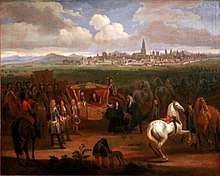
France consolidated its hold with the 1679 Treaties of Nijmegen, which brought most remaining towns under its control. France seized Strasbourg in 1681 in an unprovoked action. These territorial changes were recognised in the 1697 Treaty of Ryswick that ended the War of the Grand Alliance.
From French Revolution to the Franco-Prussian War
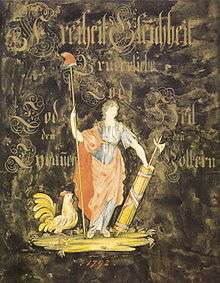
Freiheit Gleichheit Brüderlichk. od. Tod (Liberty Equality Fraternity or Death)
Tod den Tyranen (Death to Tyrants)
Heil den Völkern (Long live the Peoples)
The year 1789 brought the French Revolution and with it the first division of Alsace into the départements of Haut- and Bas-Rhin. Alsatians played an active role in the French Revolution. On 21 July 1789, after receiving news of the Storming of the Bastille in Paris, a crowd of people stormed the Strasbourg city hall, forcing the city administrators to flee and putting symbolically an end to the feudal system in Alsace. In 1792, Rouget de Lisle composed in Strasbourg the Revolutionary marching song "La Marseillaise" (as Marching song for the Army of the Rhine), which later became the anthem of France. "La Marseillaise" was played for the first time in April of that year in front of the mayor of Strasbourg Philippe-Frédéric de Dietrich. Some of the most famous generals of the French Revolution also came from Alsace, notably Kellermann, the victor of Valmy, Kléber, who led the armies of the French Republic in Vendée and Westermann, who also fought in the Vendée.
At the same time, some Alsatians were in opposition to the Jacobins and sympathetic to the restoration of the monarchy pursued by the invading forces of Austria and Prussia who sought to crush the nascent revolutionary republic. Many of the residents of the Sundgau made "pilgrimages" to places like Mariastein Abbey, near Basel, in Switzerland, for baptisms and weddings. When the French Revolutionary Army of the Rhine was victorious, tens of thousands fled east before it. When they were later permitted to return (in some cases not until 1799), it was often to find that their lands and homes had been confiscated. These conditions led to emigration by hundreds of families to newly vacant lands in the Russian Empire in 1803–4 and again in 1808. A poignant retelling of this event based on what Goethe had personally witnessed can be found in his long poem Hermann and Dorothea.
In response to the "hundred day" restoration of Napoleon I of France in 1815, Alsace along with other frontier provinces of France was occupied by foreign forces from 1815 to 1818,[2] including over 280,000 soldiers and 90,000 horses in Bas-Rhin alone. This had grave effects on trade and the economy of the region since former overland trade routes were switched to newly opened Mediterranean and Atlantic seaports.
The population grew rapidly, from 800,000 in 1814 to 914,000 in 1830 and 1,067,000 in 1846. The combination of economic and demographic factors led to hunger, housing shortages and a lack of work for young people. Thus, it is not surprising that people left Alsace, not only for Paris – where the Alsatian community grew in numbers, with famous members such as Baron Haussmann – but also for more distant places like Russia and the Austrian Empire, to take advantage of the new opportunities offered there: Austria had conquered lands in Eastern Europe from the Ottoman Empire and offered generous terms to colonists as a way of consolidating its hold on the new territories. Many Alsatians also began to sail to the United States, settling in many areas from 1820 to 1850.[3] In 1843 and 1844, sailing ships bringing immigrant families from Alsace arrived at the port of New York. Some settled in Illinois, many to farm or to seek success in commercial ventures: for example, the sailing ships Sully (in May 1843) and Iowa (in June 1844) brought families who set up homes in northern Illinois and northern Indiana. Some Alsatian immigrants were noted for their roles in 19th-century American economic development.[4] Others ventured to Canada to settle in southwestern Ontario, notably Waterloo County.
Jews
By 1790, the Jewish population of Alsace was approximately 22,500, about 3% of the provincial population. They were highly segregated and subject to long-standing antisemitic regulations. They maintained their own customs, Yiddish language, and historic traditions within the tightly-knit ghettos; they adhered to Talmudic law enforced by their rabbis. Jews were barred from most cities and instead lived in villages. They concentrated in trade, services, and especially in money lending. They financed about a third of the mortgages in Alsace. Official tolerance grew during the French Revolution, with full emancipation in 1791. However, local antisemitism also increased and Napoleon turned hostile in 1806, imposing a one-year moratorium on all debts owed to Jews. In the 1830–1870 era, most Jews moved to the cities, where they integrated and acculturated, as antisemitism sharply declined. By 1831, the state began paying salaries to official rabbis, and in 1846 a special legal oath for Jews was discontinued. Antisemitic local riots occasionally occurred, especially during the Revolution of 1848. The merger of Alsace into Germany in 1871-1918 lessened antisemitic violence.[5]
Struggle between France and united Germany
We Germans who know Germany and France know better what is good for the Alsatians than the unfortunates themselves. In the perversion of their French life they have no exact idea of what concerns Germany.
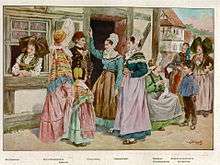
The Franco-Prussian War, which started in July 1870, saw France defeated in May 1871 by the Kingdom of Prussia and other German states. The end of the war led to the unification of Germany. Otto von Bismarck annexed Alsace and northern Lorraine to the new German Empire in 1871. France ceded more than 90% of Alsace and one-fourth of Lorraine, as stipulated in the treaty of Frankfurt. Unlike other members states of the German federation, which had governments of their own, the new Imperial territory of Alsace-Lorraine was under the sole authority of the Kaiser, administered directly by the imperial government in Berlin. Between 100,000 and 130,000 Alsatians (of a total population of about a million and a half) chose to remain French citizens and leave Reichsland Elsaß-Lothringen, many of them resettling in French Algeria as Pieds-Noirs. Only in 1911 was Alsace-Lorraine granted some measure of autonomy, which was manifested also in a flag and an anthem (Elsässisches Fahnenlied). In 1913, however, the Saverne Affair (French: Incident de Saverne) showed the limits of this new tolerance of the Alsatian identity.
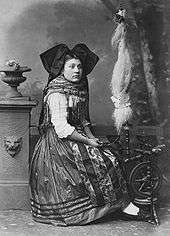
During the First World War, to avoid ground fights between brothers, many Alsatians served as sailors in the Kaiserliche Marine and took part in the Naval mutinies that led to the abdication of the Kaiser in November 1918, which left Alsace-Lorraine without a nominal head of state. The sailors returned home and tried to found an independent republic. While Jacques Peirotes, at this time deputy at the Landrat Elsass-Lothringen and just elected mayor of Strasbourg, proclaimed the forfeiture of the German Empire and the advent of the French Republic, a self-proclaimed government of Alsace-Lorraine declared its independence as the "Republic of Alsace-Lorraine". French troops entered Alsace less than two weeks later to quash the worker strikes and remove the newly established Soviets and revolutionaries from power. With the arrival of the French soldiers, many Alsatians and local Prussian/German administrators and bureaucrats cheered the re-establishment of order.[8]
Although U.S. President Woodrow Wilson had insisted that the région was self-ruling by legal status, as its constitution had stated it was bound to the sole authority of the Kaiser and not to the German state, France would allow no plebiscite, as granted by the League of Nations to some eastern German territories at this time, because the French regarded the Alsatians as Frenchmen liberated from German rule. Germany ceded the region to France under the Treaty of Versailles.
Policies forbidding the use of German and requiring French were promptly introduced. However, propaganda for elections was allowed to go with a German translation from 1919 to 2008. In order not to antagonize the Alsatians, the region was not subjected to some legal changes that had occurred in the rest of France between 1871 and 1919, such as the 1905 French law on the separation of Church and State.
Alsace-Lorraine was occupied by Germany in 1940 during the Second World War. Although it was never formally annexed, Alsace-Lorraine was incorporated into the Greater German Reich, which had been restructured into Reichsgau. Alsace was merged with Baden, and Lorraine with the Saarland, to become part of a planned Westmark. During the war, 130,000 young men from Alsace and Lorraine were conscripted into the German army, allegedly against their will (malgré-nous), and in some cases volunteered for the Waffen SS.[9] Some of the latter were involved in war crimes, such as the Oradour-sur-Glane massacre. Most perished on the eastern front. The few that could fled to Switzerland or joined the resistance. In July 1944, 1500 malgré-nous were released from Soviet captivity and sent to Algiers, where they joined the Free French Forces.
After World War II
Today, the territory is in certain areas subject to some laws that are significantly different from the rest of France – this is known as the local law.
In more recent years, the Alsatian language is again being promoted by local, national, and European authorities as an element of the region's identity. Alsatian is taught in schools (but not mandatory) as one of the regional languages of France. German is also taught as a foreign language in local kindergartens and schools. However, the Constitution of France still requires that French be the only official language of the Republic.
Timeline
| Year(s) | Event | Ruled by | Official or common language |
|---|---|---|---|
| 5400–4500 BC | Bandkeramiker/Linear Pottery cultures | - | Unknown |
| 2300–750 BC | Bell Beaker cultures | — | Proto-Celtic spoken |
| 750–450 BC | Hallstatt culture early Iron Age (early Celts) | — | None; Old Celtic spoken |
| 450–58 BC | Celts/Gauls firmly secured in entire Gaul, Alsace; trade with Greece is evident (Vix) | Celts/Gauls | None; Gaulish variety of Celtic widely spoken |
| 58 / 44 BC– AD 260 | Alsace and Gaul conquered by Caesar, provinciated to Germania Superior | Roman Empire | Latin; Gallic widely spoken |
| 260–274 | Postumus founds breakaway Gallic Empire | Gallic Empire | Latin, Gallic |
| 274–286 | Rome reconquers the Gallic Empire, Alsace | Roman Empire | Latin, Gallic, Germanic (only in Argentoratum) |
| 286–378 | Diocletian divides the Roman Empire into Western and Eastern sectors | Roman Empire | |
| around 300 | Beginning of Germanic migrations to the Roman Empire | Roman Empire | |
| 378–395 | The Visigoths rebel, precursor to waves of German, and Hun invasions | Roman Empire | Alamannic Incursions |
| 395–436 | Death of Theodosius I, causing a permanent division between Western and Eastern Rome | Western Roman Empire | |
| 436–486 | Germanic invasions of the Western Roman Empire | Roman Tributary of Gaul | Alamannic |
| 486–511 | Lower Alsace conquered by the Franks | Frankish Realm | Old Frankish, Latin; Alamannic |
| 531–614 | Upper Alsace conquered by the Franks | Frankish Realm | |
| 614–795 | Totality of Alsace to the Frankish Kingdom | Frankish Realm | |
| 795–814 | Charlemagne begins reign, Charlemagne crowned Emperor of the Romans on 25 December 800 | Frankish Empire | Old Frankish; Frankish and Alamannic |
| 814 | Death of Charlemagne | Carolingian Empire | Old Frankish; Frankish and Alamannic varieties of Old High German |
| 847–870 | Treaty of Verdun gives Alsace and Lotharingia to Lothar I | Middle Francia (Carolingian Empire) | Frankish; Frankish and Alamannic varieties of Old High German |
| 870–889 | Treaty of Mersen gives Alsace to East Francia | East Francia (German Kingdom of the Carolingian Empire) | Frankish, Frankish and Alamannic varieties of Old High German |
| 889–962 | Carolingian Empire breaks up into five Kingdoms, Magyars and Vikings periodically raid Alsace | Kingdom of Germany | Frankish and Alamannic varieties of Old High German |
| 962–1618 | Otto I crowned Holy Roman Emperor | Holy Roman Empire | Old High German, Middle High German, Modern High German; Alamannic and Franconian German dialects |
| 1618–1674 | Louis XIII annexes portions of Alsace during the Thirty Years' War, confirmed at the Peace of Westphalia | Holy Roman Empire | German; Alamannic and Franconian dialects (Alsatian) |
| 1674–1871 | Louis XIV annexes the rest of Alsace during the Franco-Dutch War, establishing full French sovereignty over the region | Kingdom of France | French (Alsatian and German tolerated) |
| 1871–1918 | Treaty of Frankfurt after the Franco-Prussian War causes French cession of Alsace to German Empire | German Empire | German; Alsatian, French |
| 1919–1940 | Treaty of Versailles after World War I causes German cession of Alsace to France | France | French; Alsatian, French, German |
| 1940–1944 | Nazi Germany conquers Alsace, establishing Gau Baden-Elsaß | Nazi Germany | German; Alsatian, French, German |
| 1945–present | French control | France | French; French and Alsatian German (declining minority language) |
See also
References
- Sherman, Irwin W. (2006). The power of plagues. Wiley-Blackwell. p. 74. ISBN 1-55581-356-9.
- Veve, Thomas Dwight (1992). The Duke of Wellington and the British army of occupation in France, 1815–1818, pp. 20–21. Greenwood Press, Westport, Connecticut, United States.
- "Cox.net". Archived from the original on 2006-05-04. Retrieved 2018-01-24.
- Ilgenweb.net Archived 23 July 2011 at the Wayback Machine
- Caron, Vicki (2005). "Alsace". In Levy, Richard S. (ed.). Antisemitism: A Historical Encyclopedia of Prejudice and Persecution. 1. pp. 13–16.
- "Full text of "Alsace-Lorraine since 1870"".
- REMAKING THE MAP OF EUROPE by Jean Finot, The New York Times, May 30, 1915
- Archive video
- Stéphane Courtois, Mark Kramer. Livre noir du Communisme: crimes, terreur, répression. Harvard University Press, 1999. p.323. ISBN 0-674-07608-7
External links
| Wikimedia Commons has media related to History of Alsace. |
- Official website of the Alsace regional council
- Alsace : at the heart of Europe – Official French website (in English)
- Alsace at Curlie
- "Museums of Alsace" (in French)
- Churches and chapels of Alsace (pictures only) (in French)
- Medieval castles of Alsace (pictures only) (in French)
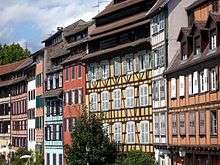
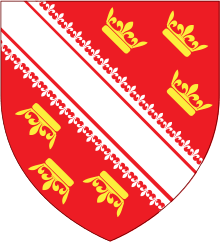
.svg.png)
